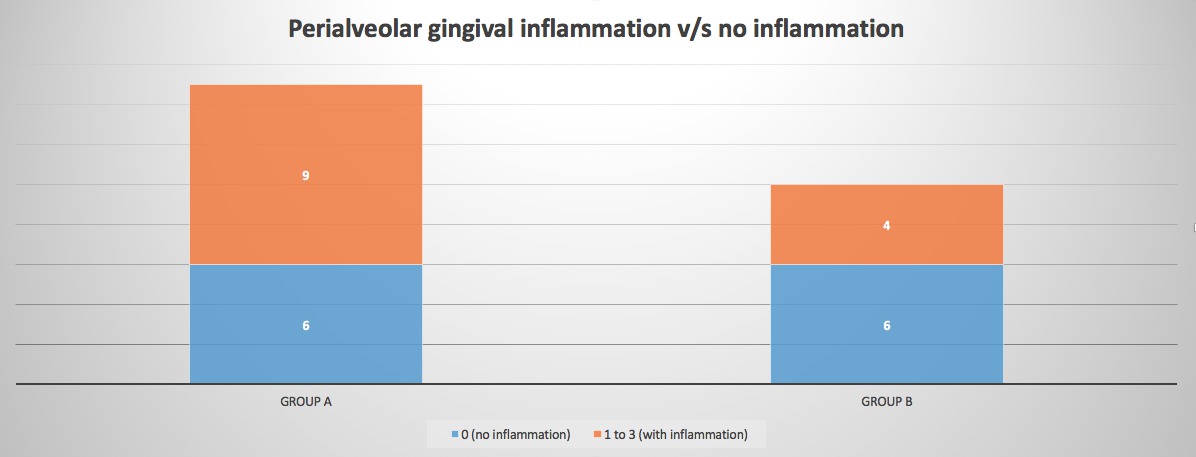IADR Abstract Archives
Assessment of hygiene measures after the simple extraction. A preliminary study
Objectives: To compare the post operative condition of the perialveolar gingival tissue posterior to the simple extraction in two groups, with and without indication of local higiene
Methods: Prospective experimental blind study on ASA I and II adult patients subjected to single or multiple dental extraction managed with silk suture.
The exclusion criteria were intraoperative complications, previous inflammation or other local conditions that prevented the objective evaluation.
A patients randomized distribution was made to perform two groups: group A formed by patients whitout the indication of local brushing, and group B by patients with soft local brushing.
At seven days a blind evaluator observed and responded a control table, which considers: the inflammatory degree of the surrounding gingiva from 0 to 3 (see table 1). The incidence of postoperative complications: describing the presence or absence with dichotomic variables (yes/no) and the clinical diagnosis.
Statistical analysis of Fisher exact test was made to correlate the incidence of inflammation of the surrounding tissue and complications with the use or non-use of this type of higienic mesures.
Results: In 11 patients, 25 post extraction alveolar sites were evaluated, of which 10 belonged to group A and 15 to Group B. 12 sites of the sample showed an inflammatory degree 0, in 11 sites an inflammatory degree was observed 1 and in 2 sites an inflammatory degree 2.
Group A: 6 sites with level 0; 8 sites with level 1 and 1 site with level 2 (9/15)
Group B: 6 sites with level 0; 3 sites with level 1; and 1 site with level 2 (4/15)
When compare both groups (considering a total value of sites with inflamatory signs) did not obtain significant differences (0.428308 on value p = 0.05)
No complications was reported.
(see table 2)
Conclusions: Conclusions: Our results indicate that the local hygiene indication with dental brush on the post extraction site does not improve the local conditions at seven days from the dental extraction.
However, under our vision is advisable to maintain local hygiene measures to reduce potential risks associated with the sepsis of de local site.
It is necessary to increase the number of the sample to obtain significant results.
Methods: Prospective experimental blind study on ASA I and II adult patients subjected to single or multiple dental extraction managed with silk suture.
The exclusion criteria were intraoperative complications, previous inflammation or other local conditions that prevented the objective evaluation.
A patients randomized distribution was made to perform two groups: group A formed by patients whitout the indication of local brushing, and group B by patients with soft local brushing.
At seven days a blind evaluator observed and responded a control table, which considers: the inflammatory degree of the surrounding gingiva from 0 to 3 (see table 1). The incidence of postoperative complications: describing the presence or absence with dichotomic variables (yes/no) and the clinical diagnosis.
Statistical analysis of Fisher exact test was made to correlate the incidence of inflammation of the surrounding tissue and complications with the use or non-use of this type of higienic mesures.
Results: In 11 patients, 25 post extraction alveolar sites were evaluated, of which 10 belonged to group A and 15 to Group B. 12 sites of the sample showed an inflammatory degree 0, in 11 sites an inflammatory degree was observed 1 and in 2 sites an inflammatory degree 2.
Group A: 6 sites with level 0; 8 sites with level 1 and 1 site with level 2 (9/15)
Group B: 6 sites with level 0; 3 sites with level 1; and 1 site with level 2 (4/15)
When compare both groups (considering a total value of sites with inflamatory signs) did not obtain significant differences (0.428308 on value p = 0.05)
No complications was reported.
(see table 2)
Conclusions: Conclusions: Our results indicate that the local hygiene indication with dental brush on the post extraction site does not improve the local conditions at seven days from the dental extraction.
However, under our vision is advisable to maintain local hygiene measures to reduce potential risks associated with the sepsis of de local site.
It is necessary to increase the number of the sample to obtain significant results.

